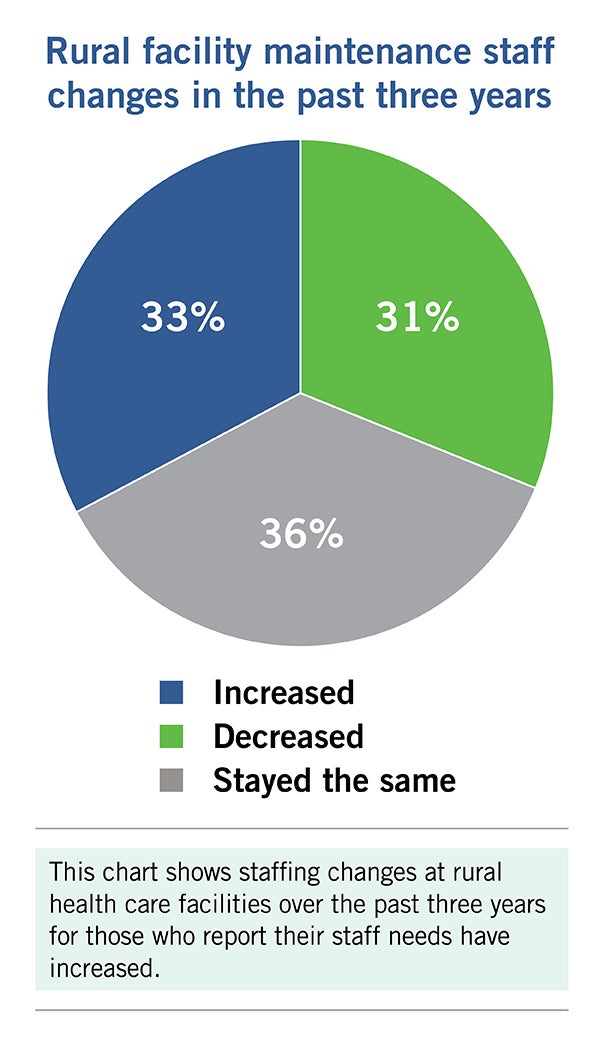Rural facilities face greater recruiting challenges
As evidenced by the American Society for Health Care Engineering’s (ASHE’s) inaugural Hospital Operations Survey, which was published in the November/December 2024 edition of Health Facilities Management, shortages in maintenance staff are an acute issue for health care facilities across the United States. In fact, 23% of the more than 400 survey respondents whose staff needs have increased over the past three years say their actual maintenance staff decreased during that same time frame. The top three factors for staff decreases are budget cuts (66%), staff resignations (52%) and staff retirements (45%).
When isolating certain demographic points, the data shows that although this problem persists across facility types, locale plays a significant role in just how dire those shortages are.
Respondents could select one or more demographic settings: urban, suburban and rural. The survey data shows that maintenance staff shortages are felt across all three location types, but they are not felt equally. Those who marked rural as at least one of their location types were hardest hit.
For instance, 62% of those in the rural category say their staff needs have increased over the past three years, but only 33% of those respondents have been able to hire more workers during that same period. The more troubling statistic is that nearly a third of those who say they need more staff have seen their maintenance workforce decrease instead, and 36% say their maintenance staff has remained steady despite increased need.
Compare this to their peers who selected urban or suburban settings. These respondents have seen slightly better success in recruiting and retaining staff.
Of those who selected suburban, 68% say their staff needs have increased over the past three years, and 42% of this subset have been able to grow their maintenance staff. Another 33% have seen their numbers stay the same, and 25% have experienced a staff decrease.
Respondents who selected urban seem to fare the best among the three categories. Sixty-four percent of these respondents say their maintenance staff needs have increased, and 41% of those respondents have seen their staff numbers follow suit. Another 40% report their numbers have stayed steady. Only 18% say their maintenance staff numbers have fallen in the wrong direction despite their increased need.
Although all three settings experience gaps in staffing, the data suggests that rural respondents feel it the most.
This trend among rural health care facilities is indicative of a national trend experienced by rural counties in general. More people are moving out of rural areas than moving in, creating workforce shortages across competing industries. Census Bureau estimates show that populations in rural counties grew by 3.4 million in the 1990s.
The next 10 years, from 2000 to 2010, saw rural population growth of 1.5 million. Between 2010 and 2020, however, rural populations declined, shedding 289,000 people.
While that is less than 1% of the 46 million people living in rural counties, it’s also the first rural population decrease the U.S. has seen since the economically turbulent Great Depression. As people move away, patient populations and staff — both clinical and nonclinical — unfortunately begin to shrink.
To help combat this issue, ASHE is piloting an initiative to boost the pipeline of available facility technicians with a “training in a box” program called the Healthcare Facility Technician Course. In collaboration with Northshore Technical Community College (NTCC) and North Oaks Health Systems, both based in rural Hammond, La., the program includes a variety of certifications, such as ASHE’s Health Care Physical Environment Worker Certification and Mechanic Evaluation and Certification for Health Care.
The first cohort launched in October 2024, and students complete four months of classroom instruction followed by six months of practical application at a North Oaks location. Those interested in participating in the program can visit https://bit.ly/facilitytechprogram to learn more.
Jamie Morgan is senior editor at Health Facilities Management magazine.


